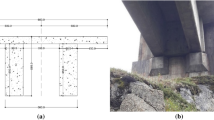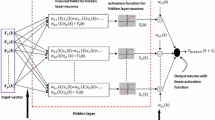Abstract
Depending on the representation ability of neural networks for a nonlinear process, this paper develops procedures to locate the input space dimensions of feedforward neural networks for general practical nonlinear systems identification when only the outputs are accessible observations. The size of the input space is directly related to the involved system order. Hence based on our developed model, we are able to determine whether the system is faulty or not by monitoring the output error change. The methods are demonstrated in vibration signals that were measured by an accelerometer mounted on a traction centre of a railway carriage running at about 60 mph along the Hong Kong railway.
Similar content being viewed by others
References
R. Isermann, “Process fault detection based on modelling and estimation methods – a survey”, Automatica, Vol. 20, No. 4, pp. 387–404, 1984.
R.J. Patton, P.M. Frank and R.N. Clark, “Fault Diagnosis in Dynamic Systems: Theory and application”, Prentice Hall: Englewood Cliffs, NJ 1989.
K.S. Narendra and K. Parthasarthy, “Identification and control of dynamical systems using neural networks”, IEEE Transactions on Neural Networks, Vol. 1, No. 1, pp. 4–27, 1990.
T. Sorsa, H.N. Koivo and H. Koivisto, “Neural networks in process fault diagnosis”, IEEE Transactions on Systems, Man & Cybernetics, Vol. 21, No. 4, pp. 815–825, 1991.
K.S. Narendra and K. Parthasarthy, “Identification and control of dynamical systems using neural networks”, IEEE Transactions on Neural Networks, Vol. 1, No. 1, pp. 4–27, 1990.
T. Sorsa and H. Koivisto, “Neural Networks in Process Fault Diagnosis”, IEEE Transactions on Systems, Man & Cybernetics, Vol. 21, No. 4, pp. 815–825, 1991.
S. Naidu, E. Zafiriou and T.J. Mcavoy, “Use of neural networks for failure detection in a control system”, IEEE Control System Magazine, Vol. 10, pp. 49–55, April 1990.
M.J. Willis, C. Di, G.A. Montague, M.T. Tham and A.J. Morris, “Artificial neural networks in process engineering”, IEE Proc.-D, Vol. 138, No. 3, pp. 256–266, 1991.
J.C. Hoskins, K.M. Kaliyur and D.M. Himemlblau, “Fault diagnoses in complex chemical plants using artificial neural networks”, AIChE Journal, Vol. 37, pp. 137–141, January 1991.
M.F. Abdel Mageed, A.F. Sakr and A. Bahgat, “Fault detection and identification using a hierarchical neural network-based system”, Proceedings of the IECON '93. International Conference on Industrial Electronics Control, and Instrumentation, pp. 338–342, Vol. 1.
R.J. Patton, J. Chen and T.M. Siew, “Fault diagnosis in nonlinear dynamic systems via neural networks”, International Conference on Control '94, Vol. 2, pp. 1346–1351.
M.J. de la Fuente and P. Vega, “A neural networks based approach for fault detection and diagnosis: application to a real process”, Proceedings of the Fourth IEEE Conference on Control Applications, pp. 188–193, 1995.
S. Fararooy and J. Allan, “On-line condition monitoring of railway signalling equipment using neural networks-based intelligent sensors”, IEE Colloquium on ‘Intelligent Measuring Systems for Control Applications’, pp. 7/1–3, 1995.
S.G. Tzafestas and P.J. Dalianis, “Fault diagnosis in complex systems using artificial neural networks”, Proceedings of the Third IEEE Conference on Control Applications, Vol. 2, pp. 877–882, 1994.
Vladik Ya. Kreinovich, “Arbitrary nonlinearity is sufficient to represent all functions by neural networks: A Theorem”, Neural Networks, Vol. 4, pp. 381–383, 1991.
G.V. Puskorius and L.A. Feldkamp, “Neurocontrol of nonlinear dynamical systems with Kalman filter trained recurrent networks”, IEEE Transactions on Neural Networks, Vol. 5, No. 2, pp. 279–297, March 1994.
L. Jin, P.N. Nikiforur and M.M. Gupta, “Adaptive model reference control of discrete-time nonlinear systems using neural networks”, Control Theory and Advanced Technology, Vol. 10, No. 4, Part 3, pp. 1379–1399, September 1995.
T.L. Ruchti, R.H. Brown and J.J. Garside, “Kalman based artificial neural network training algorithms for nonlinear system identification”, Proceedings of the 1993 International Symposium on Intelligent Control, pp. 582–587, 1993.
Asriel V. Levin and Kumpati S. Narendra, “Identification using feedforward networks”, Neural Computation, Vol. 7, pp. 349–357, 1995.
A.U. Levin and K.S. Narendra, “Control of nonlinear dynamical systems using neural networks, Part II: observability, identification and control”, IEEE Transactions on Neural Networks, Vol. 7, No. 1, January 1996.
C.L. Nikias and A.P. Petropuou, Higher-Order spectra analysis: A Nonlinear Signal Processing Framework, Prentice-Hall: Englewood Cliffs, NJ, 1993.
Jitendra K. Tugnait, “Consistent order selection for noncausal autoregressive models via higher-order statistics”, Automatica, Vol. 26, No. 2, pp. 311–320, 1990.
C.T. Leung, T.W.S. Chow and Y.F. Yam, “A novel least third-order cumulants objective function”, Neural Processing Letter, Vol. 3, No. 2, pp. 91–99, 1996.
Author information
Authors and Affiliations
Rights and permissions
About this article
Cite this article
Chow, T.W., Shuai, O. Feedforward Neural Networks Based Input-Output Models for Railway Carriage System Identification. Neural Processing Letters 5, 57–67 (1997). https://doi.org/10.1023/A:1009666009129
Issue Date:
DOI: https://doi.org/10.1023/A:1009666009129




